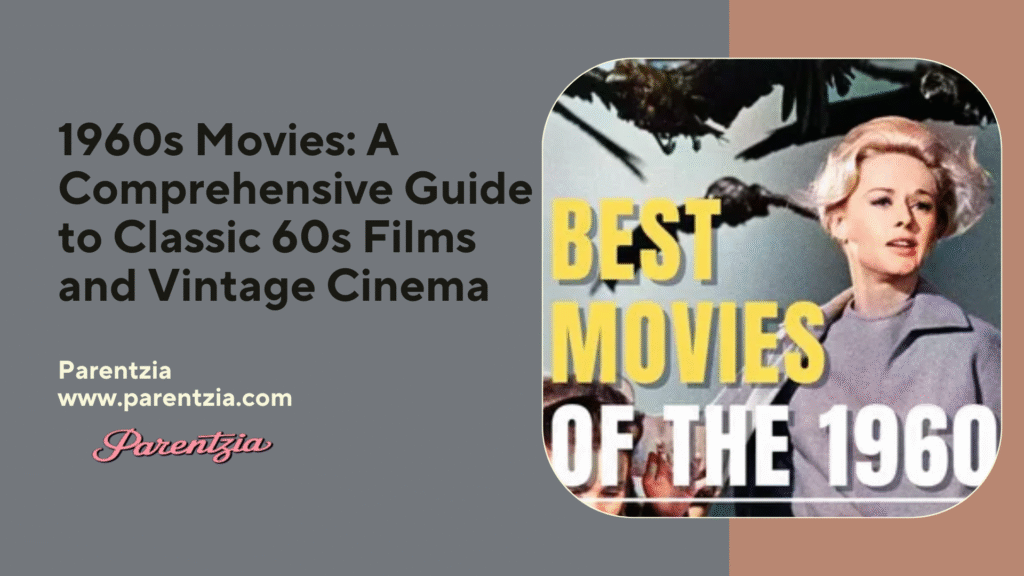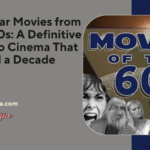The 1960s were a transformative decade for cinema. 1960s movies captured social upheaval, cultural revolutions, and groundbreaking storytelling. From Hollywood 1960s films to European art cinema, this era left an indelible mark on film history. Whether you’re exploring retro movies, old Hollywood movies, or iconic 60s films, understanding the decade’s cinematic landscape offers a glimpse into a time of innovation, rebellion, and timeless artistry.
you might also like “The Ultimate Guide to Chef Movies Every Food Lover Must Watch”
The Golden Era of Hollywood and the Rise of New Hollywood
The early 1960s represented the tail end of Golden Age cinema, dominated by studio powerhouses like MGM, Paramount, and Warner Bros. Big stars, lush production design, and sweeping narratives defined this period. Films like Breakfast at Tiffany’s (1961) starring Audrey Hepburn and Cleopatra (1963) featuring Elizabeth Taylor showcased the era’s grandeur.
Yet, by the mid-to-late 1960s, Hollywood underwent a stylistic and cultural transformation. The rise of independent filmmakers, inspired by the French New Wave and Italian neorealism, began challenging studio conventions. This cinema revolution of the 1960s brought darker themes, antiheroes, and socially conscious storytelling to the forefront.
Key Features of Golden Age vs New Hollywood Transition:
| Feature | Early 60s (Golden Age) | Late 60s (New Hollywood Influence) |
| Studios | MGM, Paramount, Warner Bros | Rise of independent production houses |
| Themes | Glamour, romance, historical epics | Counterculture, rebellion, political commentary |
| Stars | Audrey Hepburn, Elizabeth Taylor, Steve McQueen | Emerging actors: Dustin Hoffman, Jack Nicholson |
| Style | Technicolor movies 1960s, widescreen | Experimental editing, location shooting, black-and-white 60s films |
Popular 1960s Movies and Iconic Film Genres
The 1960s were remarkably diverse, spanning genres from 60s action films and 60s thrillers to 60s romance movies and 60s comedy movies. Here’s a breakdown:
60s Comedy Movies
Comedy thrived in the 1960s with classics like:
- The Pink Panther (1963) – A mix of slapstick and clever capers.
- Dr. Strangelove or: How I Learned to Stop Worrying and Love the Bomb (1964) – Stanley Kubrick 1960s masterpiece blending satire and political commentary.
- A Hard Day’s Night (1964) – Featuring The Beatles, merging music with humor and cinematic innovation.
Comedy in the 60s often reflected cultural rebellion, poking fun at authority while experimenting with narrative structures.
60s Action Films
The decade introduced iconic early James Bond movies:
- Dr. No (1962)
- From Russia With Love (1963)
Steve McQueen movies like The Great Escape (1963) also elevated action with suspenseful storytelling and thrilling stunts. Action films of the 60s increasingly emphasized realism and daring cinematography.
60s Thriller Films
Alfred Hitchcock classics dominated this era:
- Psycho (1960) – Revolutionized horror-thriller with psychological depth.
- The Birds (1963) – A pioneering example of suspense and special effects innovation.
These iconic 60s films combined cinematic techniques of the 60s with bold narrative choices, influencing decades of thrillers.
60s Romance Movies
Romance in the 60s ranged from epic to intimate:
- Breakfast at Tiffany’s (1961) – Glamour and charm defined this classic.
- The Umbrellas of Cherbourg (1964) – French New Wave musical romance with vibrant technicolor 1960s visuals.
Romantic storytelling often mirrored societal shifts, portraying women with growing independence and moral complexity.
60s Sci-Fi Movies
Science fiction captured Cold War anxieties and fascination with technology:
- 2001: A Space Odyssey (1968) – Stanley Kubrick 1960s visionary work blending philosophy and spectacle.
- Barbarella (1968) – Colorful, campy exploration of space adventure.
Sci-fi films of the decade reflected cinematic experimentation and cultural curiosity.
1960s War Films
War films portrayed both historical events and contemporary anxieties:
- The Longest Day (1962) – Detailed D-Day depiction.
- The Dirty Dozen (1967) – Combined gritty realism with thrilling action sequences.
Themes often intersected with Cold War movie themes and Vietnam War film influence, emphasizing heroism, strategy, and moral ambiguity.
International Influence: French, British, and Italian Cinema
Hollywood was not the only powerhouse. The 1960s saw European cinema redefine storytelling:
- French New Wave Films: Directors like Jean-Luc Godard (Breathless, 1960) and François Truffaut (Jules and Jim, 1962) revolutionized editing, narrative, and character psychology.
- British Cinema 1960s: Focused on gritty realism, often reflecting counterculture films and youth rebellion. Examples: A Hard Day’s Night, Alfie (1966).
- Italian Neorealism Influence: The post-war realism of the 50s continued into the 60s, impacting visual aesthetics, social commentary, and storytelling in international films.
Film Aesthetics and Technological Innovations
The 1960s embraced widescreen cinema era, Technicolor movies 1960s, and bold visual experimentation. Filmmakers explored:
- Black-and-white 60s films for stylistic and budgetary reasons.
- Cinemascope and panoramic formats for epics and action films.
- Innovative soundtracks: Iconic examples include Henry Mancini’s The Pink Panther theme and John Barry’s James Bond scores.
- Special effects evolution: 2001: A Space Odyssey redefined visual storytelling, inspiring generations of sci-fi cinema.
Oscar-Winning Films 1960s
The Academy recognized both traditional and experimental works. Oscar-winning films 1960s include:
| Year | Film | Category |
| 1960 | The Apartment | Best Picture |
| 1961 | West Side Story | Best Picture, Multiple Awards |
| 1964 | My Fair Lady | Best Picture |
| 1968 | Oliver! | Best Picture |
These films highlight both the vintage cinema charm and innovative storytelling of the decade.
Cultural and Political Context in 1960s Movies
1960s cinema mirrored society:
- Counterculture films: Explored youth rebellion, sexuality, and alternative lifestyles.
- Cold War anxieties: Films like Dr. Strangelove satirized global tension.
- Vietnam War influence: Emerging realism in war dramas questioned morality and heroism.
- Social change and civil rights: Stories began including more diverse characters and social commentary.
Movies didn’t just entertain; they shaped perceptions of culture, politics, and identity.
Hollywood Stars of the 1960s
The era’s charisma and talent remain legendary. Hollywood stars 1960s include:
- Audrey Hepburn: Fashion icon and star of Breakfast at Tiffany’s.
- Elizabeth Taylor: Glamorous and versatile, known for Cleopatra.
- Steve McQueen: Action and anti-hero magnet, led Bullitt and The Great Escape.
- Sean Connery: Defined the early James Bond persona.
- Julie Andrews: Starred in musicals like Mary Poppins (1964).
These performers helped cement the visual aesthetics of classic cinema and created lasting cultural icons.
Cult Classics and Iconic 60s Films
Some 1960s movies gained legendary status over time, becoming cult classics 60s:
- A Clockwork Orange (1971, based on Burgess’ 1962 novel, production started in late 60s influences) – controversial dystopia with lasting cultural impact.
- Easy Rider (1969) – Embodied the freedom and rebellion of counterculture cinema.
- The Graduate (1967) – Explored generational tension and youth rebellion with an innovative soundtrack.
These films often challenged norms, experimented with cinematic techniques, and remain influential today.
Top 60s Dramas and Storytelling Styles
Dramatic narratives were diverse and emotionally rich:
- Social realism: To Kill a Mockingbird (1962) tackled racial inequality.
- Psychological depth: Psycho (1960) examined human fear and morality.
- Historical epics: Lawrence of Arabia (1962) displayed sweeping storytelling and visual spectacle.
The storytelling style of the 1960s blended traditional and experimental techniques, offering layered plots and complex characters.
Music and Cinematic Soundtracks
The 1960s revolutionized iconic film soundtracks 60s:
- The Sound of Music (1965) – Julie Andrews’ voice and Rodgers & Hammerstein’s score.
- James Bond themes – John Barry’s compositions defined the spy genre.
- Beatles films – A Hard Day’s Night (1964) blended music with cinematic innovation.
Soundtracks often enhanced narrative depth and became cultural markers.
60s Movie List: Must-Watch Classics
Here’s a curated 60s movie list across genres:
| Genre | Movie | Year |
| Comedy | The Pink Panther | 1963 |
| Action | The Great Escape | 1963 |
| Thriller | Psycho | 1960 |
| Romance | Breakfast at Tiffany’s | 1961 |
| Sci-Fi | 2001: A Space Odyssey | 1968 |
| Musical | The Sound of Music | 1965 |
| War | The Longest Day | 1962 |
| Cult Classic | Easy Rider | 1969 |
This best films of the 60s list captures the era’s diversity and enduring influence.
Legacy of 1960s Movies
The 1960s reshaped cinema by introducing:
- Innovative visual aesthetics
- Bold storytelling and counterculture themes
- Expanded international influence
- Iconic stars and unforgettable soundtracks
From retro movies to vintage cinema, this decade remains a cornerstone of film history 1960s, influencing contemporary filmmakers and audiences alike.
Conclusion
1960s movies defined an era of cinematic brilliance, blending Golden Age glamour, countercultural rebellion, and international innovation. Whether you’re exploring classic 60s films, black-and-white 60s films, or technicolor movies 1960s, the decade offers a rich tapestry of genres, styles, and social commentary. Its influence on modern Hollywood, storytelling techniques, and global film culture is undeniable.
From Oscar-winning films 1960s to cult classics 60s, these movies continue to inspire, entertain, and shape the understanding of film history 1960s. For cinephiles and casual viewers alike, revisiting these iconic 60s films provides timeless insight into the artistry, culture, and vision of a transformative decade.

Tina Grey is an experienced blogger with a passion for uncovering the best in film. With years of writing and a keen eye for detail, Tina brings insightful reviews and engaging content to Parentzia. Her deep love for movies, combined with her expertise, helps readers discover must-watch films across genres. When she’s not reviewing, Tina enjoys exploring new cinematic trends and sharing her love of film with her audience.







